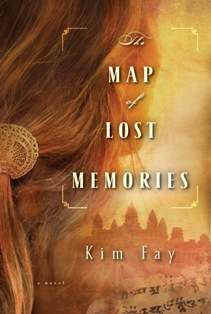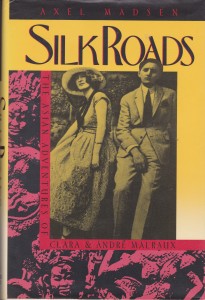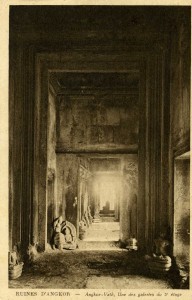The Map of Lost Memories: Debut Novelist Kim Fay Discovers Historical Fiction
Kristen Hannum
Kim Fay’s debut historical novel, The Map of Lost Memories: A Novel, set in Shanghai, China; Saigon, Vietnam; and the jungles of Cambodia, was clearly destined to be. Consider the elements:
First, Fay’s grandfather, a sailor in the Navy in the early 1930s, used to sit at the edge of her bed at night and tell her and her sister stories of his travels, bringing exotic Shanghai to life for them. The book is dedicated to him.
Second, Fay went to Asia. She’d become certified to teach English as a second language, and was ready to go nearly anywhere, but she happily landed in Vietnam. “I walked off that plane and wasn’t ten steps into the country when I fell in love with it,” she says. She lived in Saigon from 1995 to 1999, writing her third novel (she doesn’t count the ones she wrote as a child); soaking in the architecture, food, people, and history; and reading everything that came her way, most notably Silk Roads, by Axel Madsen, about André and Clara Malraux’s 1920s expeditions into the Indochinese jungle to loot art from Khmer temples to sell in the West. The couple’s hubris and sense of entitlement amazed Fay. Their story is, thus, the third element. Clara Malraux became the character Simone Merlin, nearly fully formed.
 “It all converged in one perfect storm,” says Fay, who laughs as she adds, “then 14 years later the book sold.”
“It all converged in one perfect storm,” says Fay, who laughs as she adds, “then 14 years later the book sold.”
“The book sold” puts it mildly: The Map of Lost Memories sold at auction. Editions are coming out in the United States, the United Kingdom, Denmark, Norway, Sweden, Finland, Holland, Italy, and Hungary.
Fay is appropriately gratified by all that, but what she really loves to talk about are books and writing. “It’s so sad when you get done writing and you don’t get to spend time with your characters anymore,” she says. “But now I’m realizing that I still get to talk about them and their world.”
The book’s original theme was obsession: with the cause of communism, with finding treasure, and with Cambodian art and history. Irene Blum, the protagonist, is single-mindedly determined to curate a museum devoted to Cambodian artifacts in the United States.
Fay hadn’t realized how much would come to turn on the moral questions of removing ancient art and artifacts. “I absorbed that through my research; it was just a natural progression, that cool thing that your subconscious does as you develop the story,” Fay says. “What pushed it was what I’ve seen happening in Southeast Asia now. People are still looting from the temples. The problem isn’t the tourists; it’s local looters who have destroyed so much in recent years. They use hack saws to remove the faces from the apsaras.”
The pieces then go to the global market.
 The Map of Lost Memories is set in 1925, when robber barons amassed hordes of looted plunder from places like Cambodia. Fay read everything she could on that. “If you could get the pieces out, no one could stop you,” she says. “There weren’t any laws.”
The Map of Lost Memories is set in 1925, when robber barons amassed hordes of looted plunder from places like Cambodia. Fay read everything she could on that. “If you could get the pieces out, no one could stop you,” she says. “There weren’t any laws.”
Nor was there a sense that it was wrong. That was a problem for the editors at Random House, who wanted Irene to be a bit nicer, and have at least some feelings of guilt over her scheme to loot cultural treasures. “But I wanted my characters to be of the time period, true to their era,” says Fay.
Everyone compromised. If a backward value was essential for the plot, Fay was stubborn. If it weren’t essential, offending people didn’t seem worth it. “My editor was great,” she says. “It wasn’t about ego for her. There are a couple things in the book she hates.”
Fay also skipped problematic details like seeing Asians through the Caucasian characters’ eyes. Travelogues from the 1920s convinced her that racism them was ubiquitous.
Today she’s fascinated by the questions surrounding how and why values change, something she loves to discuss with readers. “I want people to finish the book wanting to look deeper,” she says.
That may have happened for Fay herself when as a girl she read Mystery of the Emerald Buddha, by Betty Cavanna. Fay’s sister found a copy of the antique book and gave it to Fay. Rereading her early favorite, Fay was astonished to find a scene with an argument over the rights and wrongs of stealing artifacts from a Cambodian temple. “Somehow my subconscious took that little nugget and put it in my heart,” she says.
Always a reader, Fay wrote her first novel as a 10-year-old. She grew up in the Pacific Northwest, and after college Fay immersed herself in books, working for five years at Elliott Bay Book Company in Seattle.
Historical novels were among her earliest favorites, including Little Women, by Louisa May Alcott, the Little House on the Prairie series, by Laura Ingalls Wilder, and later Gone with the Wind, by Margaret Mitchell. “Mine are read to shreds; I read them over and over,” she says. “The books I remember best took place in a different place or different time. When I was little I lay in bed at night imagining living in different periods.”
She also loved Nancy Drew mysteries with their strong female protagonist and robust plots. When Fay wrote The Map of Lost Memories, it was important to her to have strong female protagonists. She had intended that hers, Simone Merlin and Irene Blum, would become better friends. “But they just never got along,” she shrugs.
Her next novel allows Fay, who is also author of To Asia with Love: a Connoisseur’s Guide to Cambodia, Laos, Thailand, and Vietnam, other Connoisseur guidebooks, and Communion: A Culinary Journey through Vietnam, to share her passion for Asian food with new readers. Her friends wondered where the food was in The Map of Lost Memories, but she explains none of the characters were foodies. “This next book lets me write about food in a way that’s integral to the story,” she says.
Set in Vietnam in the early 1960s, it’s about Lina, an American culinary anthropologist born in Vietnam. “But because it’s me, with my love of Nancy Drew, the book opens just after her best friend has been murdered,” Fay says.
Fay and her husband recently visited Saigon to learn more about Lina’s life. “Today we’re finding Lina’s house,” Fay announced one morning, for example.
She loves the research. “I can get distracted for days, following threads,” she says.

A deserted hallway in Cambodia’s Angkor Wat temple in the 1920s
Images are a favorite resource. For Map of Lost Memories, she went to Phnom Penh, found an old map and old postcards of the city, and as the days went by set the postcards around the map. She then walked her characters through the city. “I don’t see myself writing a contemporary novel again,” Fay says. “The second I started writing a historical novel I knew I’d found where I wanted to be.”
Kristen Hannum is an award-winning journalist who has reported from Japan, the Philippines, and Cambodia, as well as the United States. She’s a frequent book reviewer for The Historical Novels Review and is currently working on a mystery set in Okinawa, Japan, in the 1970s.







